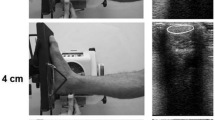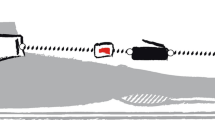Abstract
Purpose
The purpose of the present study was to compare the effects of eccentric training with different training frequencies on the blood circulation, collagen orientation, and mechanical properties of the human Achilles tendon in vivo.
Methods
Ten healthy males completed 12 weeks of a unilateral eccentric training program {(15 repetitions with knee straight and 15 repetitions with knee slightly bent) × 6 sets in a single session} for the plantar flexor muscles. They performed training three times per week on one side (3TW) and six times per week on the other side (6TW). Before and after training, changes in blood volume, coefficient of variation (CV) of echogenicity (reflects collagen fiber orientation), and stiffness of the Achilles tendon were compared by two-way analysis of variance.
Results
The tendon blood volume tended to increase after 3TW and 6TW (p = 0.064). Tendon stiffness did not change after 3TW and 6TW, whereas the elongation of tendon structures at three force levels (50, 100, and 150 N) significantly decreased with 3TW, but not 6TW. The CV of echogenicity significantly decreased after 3TW and 6TW. However, no significant differences were observed in the relative changes in these measured variables between 3TW and 6TW.
Conclusion
The present results demonstrated an increase in blood volume, the alignment of collagen fibers, and unchanged stiffness of the Achilles tendon after 12 weeks of eccentric training. Furthermore, the training frequency did not influence these training-induced changes in the tendon properties.




Similar content being viewed by others
Abbreviations
- ANOVA:
-
Analysis of variance
- CSA:
-
Cross-sectional area
- CV:
-
Coefficient of variation
- ICC:
-
Interclass correlation coefficient
- LG:
-
Lateral gastrocnemius muscle
- MA:
-
Moment arm length
- MG:
-
Medial gastrocnemius muscle
- MVC:
-
Maximal voluntary contraction
- 1RM:
-
One repetition maximum
- Oxy:
-
Oxyhemoglobin
- pη 2 :
-
Partial eta-squared
- ROI:
-
Region of interest
- SD:
-
Standard deviation
- 6TW:
-
Six times per week
- SOL:
-
Soleus muscle
- StO2 :
-
Oxygen saturation
- 3TW:
-
Three times per week
- TQ:
-
Torque values
- THb:
-
Total hemoglobin
References
Alfredson H, Pietila T, Jonsson P, Lorentzon R (1998) Heavy-load eccentric calf muscle training for the treatment of chronic Achilles tendinosis. Am J Sports Med 26(3):360–366
Arampatzis A, Karamanidis K, Albracht K (2007) Adaptational responses of the human Achilles tendon by modulation of the applied cyclic strain magnitude. J Exp Biol 210:2743–2753
Arya S, Kulig K (2010) Tendinopathy alters mechanical and material properties of the Achilles tendon. J Appl Physiol 108(3):670–675. https://doi.org/10.1152/japplphysiol.00259.2009
Bohm S, Mersmann F, Schroll A, Makitalo N, Arampatzis A (2016) Insufficient accuracy of the ultrasound-based determination of Achilles tendon cross-sectional area. J Biomech 49(13):2932–2937. https://doi.org/10.1016/j.jbiomech.2016.07.002
Child S, Bryant AL, Clark RA, Crossley KM (2010) Mechanical properties of the Achilles tendon aponeurosis are altered in athletes with achilles tendinopathy. Am J Sports Med 38(9):1885–1893. https://doi.org/10.1177/0363546510366234
Coffey VG, Reeder DW, Lancaster GI, Yeo WK, Febbraio MA, Yaspelkis BB IIIrd, Hawley JA (2007) Effect of high-frequency resistance exercise on adaptive responses in skeletal muscle. Med Sci Sports Exerc 39(12):2135–2144. https://doi.org/10.1249/mss.0b013e31815729b6
de Villarreal ESS, Gonzalez-Badillo JJ, Izquierdo M (2008) Low and moderate plyometric training frequency produces greater jumping and sprinting gains compared with high frequency. J Strength Cond Res 22:715–725
de Vos RJ, Heijboer MP, Weinans H, Verhaar JA, van Schie JT (2012) Tendon structure’s lack of relation to clinical outcome after eccentric exercises in chronic midportion Achilles tendinopathy. J Sport Rehabil 21(1):34–43
De Jonge S, Warnaars JL, De Vos RJ, Weir A, van Schie HT, Bierma-Zeinstra SM, Verhaar JA, Tol JL (2014) Relationship between neovascularization and clinical severity in Achilles tendinopathy in 556 paired measurements. Scand J Med Sci Sports 24(5):773–778. https://doi.org/10.1111/sms.12072
Fahlstrom M, Jonsson P, Lorentzon R, Alfredson H (2003) Chronic Achilles tendon pain treated with eccentric calf-muscle training. Knee Surg Sports Traumatol Arthrosc 11(5):327–333. https://doi.org/10.1007/s00167-003-0418-z
Foure A, Nordez A, Cornu C (2013) Effects of eccentric training on mechanical properties of the plantar flexor muscle-tendon complex. J Appl Physiol 114(5):523–537. https://doi.org/10.1152/japplphysiol.01313.2011
Frohm A, Saartok T, Halvorsen K, Renstrom P (2007) Eccentric treatment for patellar tendinopathy: a prospective randomised short-term pilot study of two rehabilitation protocols. Br J Sports Med 41(7):e7. https://doi.org/10.1136/bjsm.2006.032599
Ishigaki T, Kouno M, Ikebukuro T, Kubo K (2016) Quantification of collagen fiber orientation in human tendons with the coefficient of variation of echogenicity. J Biomech 49(16):3923–3927. https://doi.org/10.1016/j.jbiomech.2016.11.004
Ishigaki T, Ikebukuro T, Kubo K (2018) Effects of repeated eccentric contractions with different loads on blood circulation and collagen fiber orientation in the human Achilles tendon. J Physiol Fit Sports Med 7:57–64
Jenkins ND, Housh TJ, Bergstrom HC, Cochrane KC, Hill EC, Smith CM, Johnson GO, Schmidt RJ, Cramer JT (2015) Muscle activation during three sets to failure at 80 vs. 30% 1RM resistance exercise. Eur J Appl Physiol 115(11):2335–2347. https://doi.org/10.1007/s00421-015-3214-9
Khan KM, Cook JL, Bonar F, Harcourt P, Astrom M (1999) Histopathology of common tendinopathies. Update and implications for clinical management. Sports Med 27(6):393–408
Kim YS, Park J, Hsu J, Cho KK, Kim YH, Shim JK (2010) Effects of training frequency on lumbar extension strength in patients recovering from lumbar discectomy. J Rehabil Med 42:839–845
Kubo K (2015) Effects of repeated concentric and eccentric contractions on tendon blood circulation. Int J Sports Med 36(6):481–484. https://doi.org/10.1055/s-0034-1398649
Kubo K, Yata H (2017) Effects of concentric and eccentric training on the stiffness and blood circulation of patellar tendon. Sports Med Int Open 1:E43–E49
Kubo K, Kanehisa H, Kawakami Y, Fukunaga T (2001) Influences of repetitive muscle contractions with different modes on tendon elasticity in vivo. J Appl Physiol 91(1):277–282
Kubo K, Ikebukuro T, Yaeshima K, Yata H, Tsunoda N, Kanehisa H (2009) Effects of static and dynamic training on the stiffness and blood volume of tendon in vivo. J Appl Physiol 106:412–417
Kubo K, Yajima H, Takayama M, Ikebukuro T, Mizoguchi H, Takakura N (2011) Changes in blood circulation of the contralateral Achilles tendon during and after acupuncture and heating. Int J Sports Med 32(10):807–813. https://doi.org/10.1055/s-0031-1277213
Kubo K, Ikebukuro T, Maki A, Yata H, Tsunoda N (2012) Time course of changes in the human Achilles tendon properties and metabolism during training and detraining in vivo. Eur J Appl Physiol 112(7):2679–2691. https://doi.org/10.1007/s00421-011-2248-x
Langberg H, Skovgaard D, Petersen LJ, Bulow J, Kjaer M (1999) Type I collagen synthesis and degradation in peritendinous tissue after exercise determined by microdialysis in humans. J Physiol 521:299–306
Lehtinen A, Bondestam S, Taavitsainen M (1994) Use of angulation in the detection of tendinitis with US. Eur J Radiol 18(3):175–179
Lin TW, Cardenas L, Soslowsky LJ (2004) Biomechanics of tendon injury and repair. J Biomech 37(6):865–877. https://doi.org/10.1016/j.jbiomech.2003.11.005
Malliaras P, Kamal B, Nowell A, Farley T, Dhamu H, Simpson V, Morrissey D, Langberg H, Maffulli N, Reeves ND (2013) Patellar tendon adaptation in relation to load-intensity and contraction type. J Biomech 46(11):1893–1899. https://doi.org/10.1016/j.jbiomech.2013.04.022
Miller BF, Olesen JL, Hansen M, Dossing S, Crameri RM, Welling RJ, Langberg H, Flyvbjerg A, Kjaer M, Babraj JA, Smith K, Rennie MJ (2005) Coordinated collagen and muscle protein synthesis in human patella tendon and quadriceps muscle after exercise. J Physiol 567:1021–1033. https://doi.org/10.1113/jphysiol.2005.093690
Obst SJ, Newsham-West R, Barrett RS (2016) Changes in Achilles tendon mechanical properties following eccentric heel drop exercise are specific to the free tendon. Scand J Med Sci Sports 26(4):421–431. https://doi.org/10.1111/sms.12466
Ochi E, Maruo M, Tsuchiya Y, Ishii N, Miura K, Sasaki K (2018) Higher training frequency is important for gaining muscular strength under volume-matched training. Front Physiol 9:744
Ohberg L, Alfredson H (2004) Effects on neovascularisation behind the good results with eccentric training in chronic mid-portion Achilles tendinosis? Knee Surg Sports Traumatol Arthrosc 12(5):465–470. https://doi.org/10.1007/s00167-004-0494-8
Pardes AM, Beach ZM, Raja H, Rodriguez AB, Freedman BR, Soslowsky LJ (2017) Aging leads to inferior Achilles tendon mechanics and altered ankle function in rodents. J Biomech 60:30–38. https://doi.org/10.1016/j.jbiomech.2017.06.008
Rees JD, Wilson AM, Wolman RL (2006) Current concepts in the management of tendon disorders. Rheumatology 45(5):508–521. https://doi.org/10.1093/rheumatology/kel046
Rees JD, Maffulli N, Cook J (2009) Management of tendinopathy. Am J Sports Med 37(9):1855–1867. https://doi.org/10.1177/0363546508324283
Starbuck C, Eston RG (2012) Exercise-induced muscle damage and the repeated bout effect: evidence for cross transfer. Eur J Appl Physiol 112(3):1005–1013. https://doi.org/10.1007/s00421-011-2053-6
van Schie HT, de Vos RJ, de Jonge S, Bakker EM, Heijboer MP, Verhaar JA, Tol JL, Weinans H (2010) Ultrasonographic tissue characterisation of human Achilles tendons: quantification of tendon structure through a novel non-invasive approach. Br J Sports Med 44(16):1153–1159. https://doi.org/10.1136/bjsm.2009.061010
Verrall GM, Dolman BK, Best TM (2017) Applying physical science principles to mid-substance Achilles tendinopathy and the relationship to eccentric lengthening exercises. Scand J Med Sci Sports. https://doi.org/10.1111/sms.12978
Wang XT, Ker R, Alexander RM (1995) Fatigue rupture of wallaby tail tendons. J Exp Biol 198:847–852
Wang CJ, Wang FS, Yang KD, Weng LH, Hsu CC, Huang CS, Yang LC (2003) Shock wave therapy induces neovascularization at the tendon-bone junction. A study in rabbits. J Orthop Res 21(6):984–989. https://doi.org/10.1016/S0736-0266(03)00104-9
Wang HK, Lin KH, Su SC, Shih TT, Huang YC (2012) Effects of tendon viscoelasticity in Achilles tendinosis on explosive performance and clinical severity in athletes. Scand J Med Sci Sports 22(6):e147–e155. https://doi.org/10.1111/j.1600-0838.2012.01511.x
Yasuda Y, Miyamura M (1983) Cross transfer effects of muscular training on blood flow in the ipsilateral and contralateral forearms. Eur J Appl Physiol Occup Physiol 51(3):321–329
Zamora AJ, Marini JF (1988) Tendon and myo-tendinous junction in an overloaded skeletal muscle of the rat. Anat Embryol 179:89–96
Acknowledgements
This study was supported by a Grant-in-Aid for JSPS Research Fellow (16J07375 to T. Ishigaki) and a Grant-in-Aid for Scientific Research (B) (17H02149 to K. Kubo) from the Japan Society for the Promotion of Science (JSPS).
Author information
Authors and Affiliations
Contributions
All authors approved to submit this manuscript. The contributions of all authors were as follows: Keitaro Kubo: conception of this study, acquisition of data, drafting the manuscript. Tomonobu Ishigaki: acquisition of data, analysis data, drafting figures and tables.
Corresponding author
Additional information
Communicated by Toshio Moritani.
Rights and permissions
About this article
Cite this article
Ishigaki, T., Kubo, K. Effects of eccentric training with different training frequencies on blood circulation, collagen fiber orientation, and mechanical properties of human Achilles tendons in vivo. Eur J Appl Physiol 118, 2617–2626 (2018). https://doi.org/10.1007/s00421-018-3985-x
Received:
Accepted:
Published:
Issue Date:
DOI: https://doi.org/10.1007/s00421-018-3985-x




